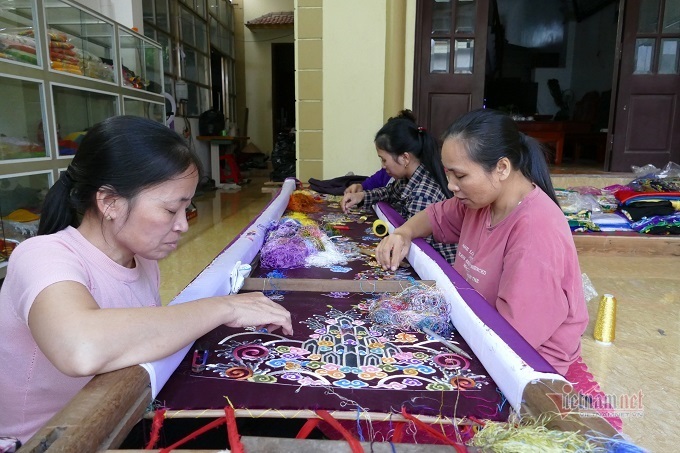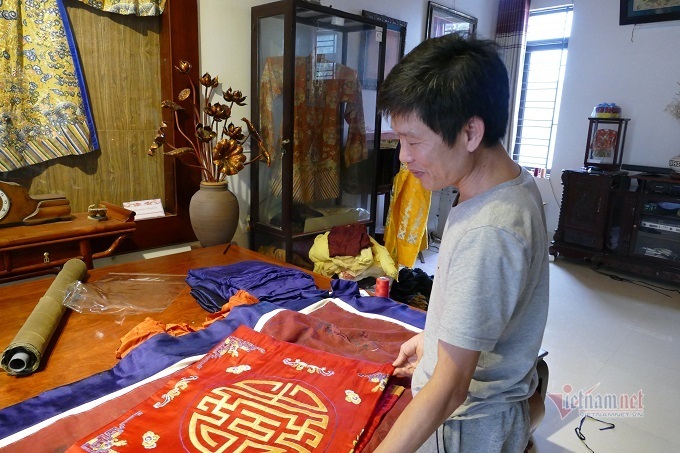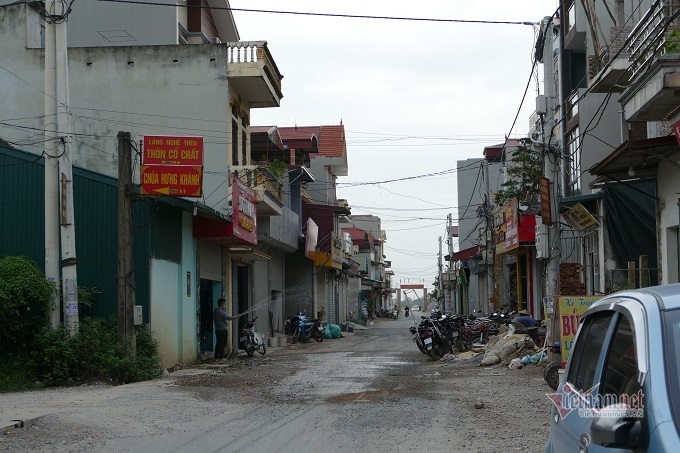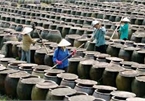The village’s artisans were hired to make the king's robes and costumes for mandarins and nobles. Today, Dong Cuu’s embroiderers make old-style costumes and items for festivals, religious events and film projects.
Dong Cuu’s embroiderers still make products manually, and do not use machines as embroiderers do at other craft villages.
Embroiderers and People's Artist Vu Van Gioi, 51, said that there was a period of time when the villagers quit their job, but Gioi and his family members still made performance costumes for art troupes and bedding and tablecloths for export to Eastern Europe.
 |
|
Dong Cuu village’s embroiderers. |
Gioi was a soldier when he was young. After being discharged from the army, he opened a carpentry workshop while still embroidering “y mon” (the curtain hung in front of altars) to sell to handicraft shops in Hanoi Old Quarter. Gioi has devoted his full time to embroidery since his father died.
Gioi's father, before getting sick and passing away, signed a big contract to make costumes for a cai luong (southern folk music) troupe. To maintain his father’s prestige, Gioi quit other jobs to focus his mind and heart in fulfilling the contract. After that, he continued to pursue the embroidery profession.
 |
|
People's Artist Vu Van Gioi.
|
Gioi said, in the past, the costumes and items for festivals and religious events were simple, with a few small flowers or letters embroidered. Later, people preferred patterns with dragons, phoenixes and lotus flowers.
Along with the country’s development, Vietnamese have become more keen on festivals and religious events, so Dong Cuu village’s traditional profession has become more prosperous. Gioi and his family are busy all year round and they have to compete with time to fulfill contracts. Many overseas Vietnamese and foreigners come to the village to directly buy embroidery products, Gioi said.
 |
|
The road to Dong Cuu village, with big houses along the sides.
|
According to Dong Cuu’s embroiders, there are many kinds of products, from products made in mass production to handmade ones. Embroidery products mainly belong to two types: for religious rites like scarves and costumes for hau dong rituals (receiving incarnations of the deities) and costumes for performance of traditional arts like cai luong, cheo, tuong…
Embroidery products made in mass production are priced several hundreds of thousands of VND (tens of USD). Handmade products, with simple patterns, are sold for several to dozens of millions VND (Over $100 to several thousands of USD).
For designed products, embroidered with sophisticated patterns like flowers, dragons or phoenixes and special materials like
gold thread or jade or pearls attached, the price can reach tens of or hundreds of thousands of USD/product.
“The expensive costumes used at hau dong rituals are not only costumes but have cultural values that cannot be measured by money,” said artisan Gioi.
At present, Gioi only makes designed embroidery products.
Unique embroidery technique
|
A product made by artisan Gioi.
|
Dang Van Thang, Chairman of Dung Tien commune, Dong Cuu village, has 572 households, with up to 90% of them working in embroidery. The village has over 100 large-scale embroidery workshops.
Before 1995, embroidery was an extra job, but today the job has helped many families get rich.
Like other craft villages, embroidery in Dong Cuu village is preserved from generation to generation. Many 5-year-old children here are able to hold the needle properly.
In 2017, the Ministry of Culture, Sports and Tourism recognized the embroidery profession of Dong Cuu Village as a National Intangible Cultural Heritage.
There are many embroidery villages in Vietnam, but the embroidery in Dong Cuu is considered a cultural heritage for its special techniques used in the profession.
People's artist Vu Van Gioi said the embroidery of costumes must comply with strict regulations. For example, the thread used to embroider the king’s rope must be two-way spinning thread while it is one-way spinning thread for embroidering the queen's dress. All stitches must be smooth and very straight.
Dong Rescue village has its own embroidery techniques. The village's most unique technique is embroidery using gold or silver lame threads. Artisans use gold and silver lame threads to embroider contours of motifs such as dragon's nail, dragon's scales, cloud veins, etc.
 |
|
This piece of fabric will be sewn into the costume after being embroidered.
|
Such technique helps the motifs stand out and create a sharp, lifelike texture. You can see the dragon and phoenix moving with the wearer's footsteps.
Using this technique, according to Mr. Gioi, the gold and silver lame threads are placed on the fabric and the worker uses the silk thread to fix the gold and silver lame threads on the fabric. This step requires skilled craftsmen.
Ms. Nguyen Thi San, owner of an embroidery establishment, said that, using modern embroidering technique, workers are free to adjust stitches but under the old technique, each stitch must always follow a certain direction.
 |
|
At an embroidery workshop in Dong Cuu village.
|
 |
|
Ms. San shows a scarf she has just finished.
|
Workers must practice from three to five years to master the ancient embroidery techniques. Each product has to apply different types of embroidery. Not many embroiderers can complete the whole process. They are usually divided into groups and each group performs one stage.
For this reason, products made by old embroidery techniques need a whole month or even several months to be finished. As a result, the prices range from a few hundred million to billions of VND/product.
“Sophisticated embroidery techniques require time and skill of the craftsman. If a product is made by senior artisans, the price will be very high. Each year my workshop only makes 3-4 products of this kind,” San said.
Thai Minh

Visit the oldest fish sauce craft village in Da Nang
The 400-year-old Nam O fish sauce craft village in Nam O Village is one of the must-visit places in the central city of Da Nang, besides Bà Nà Hill and Sơn Trà Peninsula.